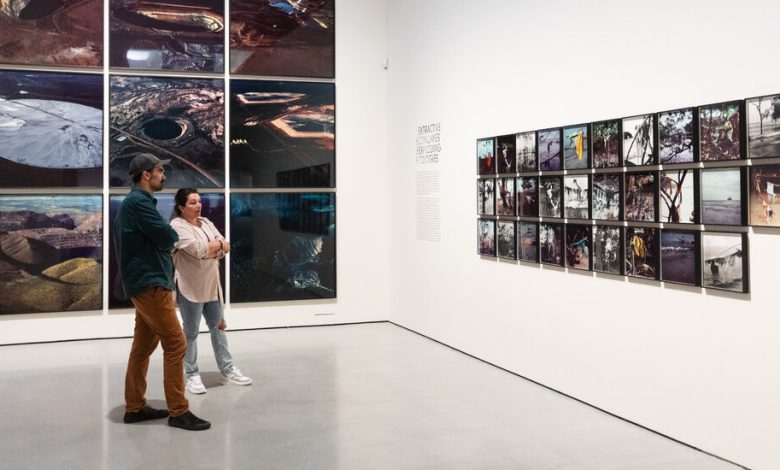In This Exhibition, Gender Meets Climate Activism. It’s a Lot.

“We won’t play nature to your culture,” declares a 1983 work by the American artist Barbara Kruger, known for her biting pairings of text and image. The phrase runs across a black-and-white close-up of a woman’s face as she lies in the grass, her hair merging with the ground, a slender leaf placed over each of her eyes, as if reductive binaries — whether they’re between nature and culture, female and male, the body and the mind — render us blind.
Forty years ago, this piece gave its title to a solo exhibition of Kruger’s work at London’s Institute of Contemporary Arts. This fall, across town, it opens “Re/Sisters: A Lens on Gender and Ecology”at the Barbican Art Gallery, which runs through Jan. 14, 2024. This sprawling survey of 250 works by almost 50 women and gender nonconforming artists from the 1960s to today is presented under the broad banner of “ecofeminism,” a school of thought that links gender oppression with humanity’s destruction of nature.
With 2023 on track to become the hottest year on record, and with evidence mounting that women and girls are disproportionately affected by climate change, the exhibition is timely. It is also nonprescriptive: The definitions of identity and feminism on display are loose and varied, as are the approaches to art and climate-focused activism.
Paradoxically, that inclusivity unsettles the show’s overall aims. The curatorial strategy of highlighting urgent issues ultimately flattens art that is politically and aesthetically nuanced, and rooted more in experience than explanation. Sometimes, less really is more.
Still, close looking is rewarded. Two grids of photographs by Simryn Gill, a Singapore-born artist, address the impacts, small and large, of industry on the environment. “Channel” (2014) shows colorful remnants of plastic bags torn and tangled in the shoreline foliage of Port Dickson, a Malaysian coastal town. “Eyes and Storms” (2012) captures, in aerial photographs, the man-made scars of the Pilbara region of Western Australia. From high above, the open-pit mines, dams and lakes gape like wounds, and glitter like alien eyeballs. Despite their terrible implications, the images in both installations are eerily seductive.
But those aren’t the only photo grids in the show. There are many others, and though they are the products of radically dissimilar creative practices and politics, they begin to resemble each other when repeated room after room: images of the earth, images of women in landscapes, women’s bodies melding with nature.
A room devoted to protest offers a more raucous, energetic display. Documentation of the Greenham Common Women’s Peace Camp, a British action against nuclear disarmament, appears with Pamela Singh’s 1994 photographs of the Chipko tree-huggers of the Himalayas and Poulomi Basu’s ten-year project about the women of the People’s Liberation Guerrilla Army, a banned Maoist organization in India.
Where the women of Greenham Common chained themselves to fences, and erected camps and day care centers, the women of the P.L.G.A. took up arms. In “Re/Sisters,” passive direct action sits productively alongside violent struggle — a reminder of different means and ends.
Other groupings offer a lineage of feminist photography rooted in individual, often solitary, engagement with nature. In her performance-based photographs from the 1970s, Ana Mendieta’s nude form disappears beneath thick bunches of white flowers or is camouflaged, covered in mud, against a tree trunk.
Francesca Woodman flickers in and out of her small, beguiling black-and-white images of the same period, taken in Rhode Island and Rome. In one, she is partially submerged beneath the roots of a waterside tree, in another her slender raised arms wear cuffs of birch bark.
The show is not all sober requiem. Tee A. Corrinne’s 1986 photomontages of vulvas in the landscape — including “Isis in the Woods,” “Isis in the Ivy,” “Isis in the Sky” — are very fleshy and very funny in their appropriation of mother-earth literalism. Anne Duk Hee Jordan’s immersive installation “Ziggy and the Starfish”(2022) provides hammocks and enormous prawn-pillows from which to view a film of sexually fluid aquamarine life set to soothing muzak.
Some of the most rewarding works in the exhibition are those that engage with the show’s titular “lens” to question the veracity of photographic images. For Ingrid Pollard’s 2017 series, “The Valentine Days,” she enlarged and hand-tinted British colonial-era tableaux of Jamaican life, romantically staged to promote speculative development in the Caribbean.
Zoe Leonard’s “Al Río / To the River”(2016-2022), forensic black-and-white studies of life along the Rio Grande, the river that separates Mexico and Texas, hung nearby. Looking closely, the river, flowing and lively, unites rather than separates life on both sides — not a border but a membrane.
It was difficult for quiet works like these to hold space in the vast array of “Re/Sisters.” In many ways, the exhibition’s ambitions created its greatest challenges. Artist biographies, cultural and global contexts are all sped through, alongside cursory information about at least a century of diverse and complicated industrial practices.
These wall-texts are tough going, awkwardly squeezing complex forces into interchangeable abstractions: “cis-heteropatriarchal Western extractive capitalism,” or “capitalist military-industrial-agricultural-nuclear complex,” for instance.
I was stumped when asked to “reflect on the fluidity of bodies of water” and, as in so many other exhibitions of the moment, left unsure what constitutes “the radical power of care.” This language feels empty, especially when deployed in the art world, where political engagement is often canny and superficial.
“Re/Sisters” makes clear what ecofeminist art and artists can do — and have done — to confront norms, but what art institutions can do remains murky. An acknowledgment text provides information about the gallery’s efforts at sustainability: keeping the lights low, making some frames locally, investing in a local environment project and sponsorship by Vestiaire Collective, the second-hand fashion app.
But this all feels box-checking, and “Re/Sisters” does not disrupt exhibition conventions of documentation and explication. If ecofeminism is a behavior, it cannot be fully captured by a static “lens.” Inside gallery walls, we need new ways of being, as much as ways of seeing.




